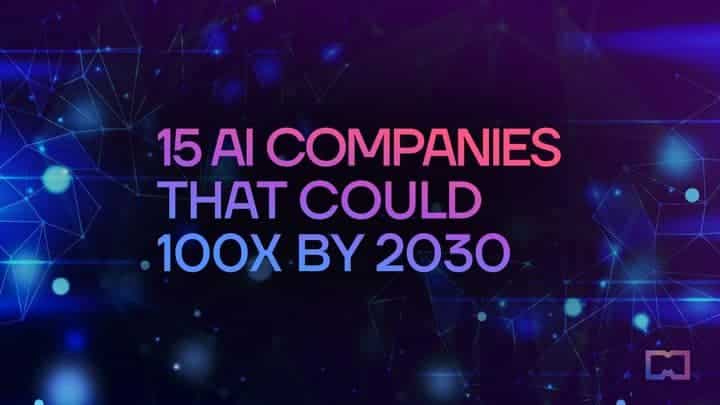In this article, we embark on a journey to explore “15 AI Stocks that Could 100x by 2030.” These companies have been carefully selected based on rigorous criteria, including market demand, technological innovation, leadership, and funding. Each of them boasts a unique story, a portfolio of cutting-edge products and services, and the potential to disrupt their respective industries.

Understanding AI
AI, or Artificial Intelligence, refers to the simulation of human intelligence in machines. It involves creating computer programs and systems that can perform tasks that typically require human intelligence, such as learning from experience, recognizing patterns, solving problems, and making decisions.
The artificial intelligence (AI) industry is expected to grow exponentially over the next decade. As AI becomes more widely adopted across sectors, companies leveraging AI have the potential to see tremendous growth. In this article, we analyze 15 public AI companies that could potentially 100x in value by the year 2030 based on their technology, market opportunities, leadership, and more.
Criteria for Selection
Selecting companies with the potential to grow a hundredfold in a mere decade is no small task. Our criteria for choosing these 15 AI companies were rigorous, including factors like market demand, technological innovation, leadership, and investment. Let’s take a closer look at what sets these companies apart.
1. Nvidia (NVDA)
Nvidia (NVDA) is one of the leading companies at the forefront of the artificial intelligence (AI) industry. While the company is widely recognized for its GPUs and contributions to gaming, its GPUs have also become a fundamental tool for AI and deep learning applications. Nvidia’s GPUs are used extensively in data centers and supercomputers for AI workloads, making it a key player in the AI infrastructure space.
Nvidia’s AI-related products include the Nvidia Tesla GPUs, which are specifically designed for AI and high-performance computing, and the Nvidia Deep Learning AI platform, which provides software and tools for AI development. The company’s innovations have been instrumental in enabling breakthroughs in areas like natural language processing, computer vision, and autonomous vehicles.
With a strong focus on AI, Nvidia is well-positioned to capitalize on the continued growth of the AI industry. As AI adoption continues to expand across various sectors, including healthcare, autonomous vehicles, and finance, Nvidia’s AI technologies are likely to play a crucial role in shaping the future of AI-powered applications.
Looking ahead to 2030, NVIDIA’s stock could reach $1,000 per share, representing a substantial increase compared to its current market cap of $500 billion. This optimistic outlook is based on several factors, including NVIDIA’s continued leadership in key growth markets such as AI, high-performance computing, autonomous vehicles, and the metaverse. These sectors are expected to rely heavily on GPU power, which is one of NVIDIA’s core strengths.
Pros:
Cons:
2. IBM
IBM is an early pioneer in artificial intelligence research and applies AI across its enterprise software and consulting businesses. With decades of experience in AI research, IBM developed the Watson AI platform which defeated human champions on Jeopardy! in 2011. Today, IBM leverages AI across areas like its Watson Assistant chatbot, supply chain optimizations, and predictive analytics offerings.
As a trusted enterprise brand, IBM has deep expertise in industry-specific AI use cases in highly regulated sectors like finance, healthcare, government, and more. Its acquisition of Red Hat also bolsters its hybrid cloud and AI solution capabilities. If IBM can modernize its brand perception beyond legacy hardware/IT services through leading in enterprise AI applications, its stock could potentially double from today’s $140 billion market cap by 2030. But challenges remain in declining legacy businesses and translating its pioneering research into commercial success.
Pros:
Cons:
3. Amazon (AMZN)
Amazon () dominates the public cloud market with AWS, providing the scalable compute power needed for AI workloads. It also applies AI across its massive ecommerce operations.
Amazon Web Services (AWS) offers industry-leading AI services and tools that allow organizations to build AI applications on the cloud. This includes services like SageMaker for developing machine learning models, Lex for building conversational interfaces, Rekognition for adding image and video analysis, and Forecast for creating predictive analytics models.
AWS makes it easy for companies to leverage advanced AI capabilities without investing heavily in on-premise infrastructure. Given Amazon’s continued growth and demand for public cloud services, AWS is poised to benefit enormously from the migration of AI workloads to the cloud going forward. The large trove of ecommerce and shopping data also provides an advantage for Amazon in developing retail-focused AI.
The widespread need for scalable cloud infrastructure to run computationally intensive AI workloads positions AWS as a frontrunner to dominate the AI cloud space in the next decade. By 2030, one projection estimates that Amazon stock could potentially reach $5,000 per share driven by the central role of AWS in enterprise AI adoption.
Pros:
Cons:
4. C3.ai (AI)
C3.ai provides a comprehensive suite of enterprise AI software including tools for AI application development, machine learning, and managing AI projects.
The C3 AI Suite allows organizations to rapidly build, deploy, and operate enterprise-scale AI applications by handling tasks like preprocessing data, feature engineering, model training, and monitoring. This helps overcome many challenges faced in implementing AI at scale.
C3.ai has deep expertise applying AI to industry use cases like predictive maintenance across its 100+ customers in oil/gas, aerospace, chemicals, and other complex sectors. Its model-driven architecture also streamlines developing and maintaining AI models.
While C3.ai faces risks from increased competition, its first mover advantage in offering an integrated enterprise AI software platform provides a growth runway as more companies accelerate AI adoption. There is potential for the stock to reach $250 by 2030, a near 10x increase from its current $3 billion market cap.
Pros:
Cons:
5. Micron Technology (MU)
Micron Technology manufactures advanced memory and storage solutions critical for the rapid data access needed for AI model training and inference. Micron produces DRAM and flash storage chips that are integral to powering AI workloads which need to process massive amounts of data very quickly. Its memory and storage solutions are built specifically to handle AI/ML data-intensive workloads.
The company has established partnerships with major players across the AI ecosystem including NVIDIA, Intel, IBM, Google, Microsoft, and Amazon. It is well-positioned to grow as demand for memory and data storage scales up with AI adoption.
Micron aims to continue introducing faster, higher capacity memory and storage innovations tailored for AI applications. If successful, the bull case is that Micron stock could reach $350 by 2030, a 4-5x increase from today driven by the central role of data infrastructure in AI.
Pros:
Cons:
6. Alphabet (GOOGL)
Alphabet, the parent company of Google and DeepMind, is uniquely positioned as a pioneer in AI research and in applying AI across its products and services. Alphabet spends billions on foundational and applied AI research through Google Research, Google Brain, DeepMind, Waymo, and other divisions. These labs publish pioneering work in natural language processing, computer vision, robotics, and more.
The company also has unmatched data resources from billions of Google users and products like Search, Maps, YouTube, etc. to improve its AI algorithms. Google Search in particular should benefit from more advanced NLP and recommendation engines.
Leveraging its AI capabilities, Alphabet has growth opportunities in areas like advertising, cloud computing, autonomous vehicles, and smart home devices. However, attracting and retaining AI talent against big tech rivals will be challenging. Increased regulatory scrutiny around privacy and antitrust practices also poses risks.
Pros:
Cons:
7. Meta Platforms (META)
Meta Platforms, formerly Facebook, leverages leading-edge AI for targeted social media advertising and its vision for the metaverse virtual world. Meta has invested heavily in AI research to improve ad targeting, develop natural language processing, advance computer vision technology, and power its future metaverse ambitions.
Initiatives like the Facebook AI Research lab push the boundaries of machine learning capabilities. On the social media side, Meta can leverage its massive user data advantage from platforms like Facebook, Instagram, WhatsApp, and Messenger to train and refine AI algorithms. The work on VR/AR technologies for the proposed metaverse also relies on innovative AI applications.
If Meta can achieve its vision of an immersive metaverse platform powered by lifelike avatars, realistic simulated environments, and seamless VR/AR hardware, it could see substantial growth in its currently $800+ billion market valuation. But Meta faces brand reputation challenges, potential AI ethics concerns, and uncertain execution risk on its futuristic plans.
Pros:
Cons:
8. Apple (AAPL)
Apple is renowned for its design prowess in integrating AI seamlessly across its hardware products, software, and services. Apple uses AI to enhance experiences across products like Siri, Photos, the Camera app, Safari recommendations, the App Store, and more. Tight integration of proprietary silicon like the Neural Engine with software gives Apple an edge in consumer AI.
The company also has an enormous base of affluent users willing to pay a premium for intuitive, easy-to-use devices powered by AI. Apple preserves user privacy by performing most AI processing on-device rather than in the cloud.
Maintaining innovation momentum across its growing array of consumer devices and services will be critical for Apple to sustain dominance as an AI-driven premium consumer brand through 2030 and beyond.
Pros:
Cons:
9. Symbotic (SYM)
Symbotic provides an AI-enabled robotics automation system for optimizing supply chain operations like warehouse fulfillment.Symbotic is pioneering a new approach to supply chain automation using AI software and robotics. Their integrated system is over 10 years ahead of competitors based on R&D.
Major customers include Walmart, which is rolling out Symbotic’s systems across dozens of distribution centers. With a $9 billion addressable market in modernizing warehouse infrastructure, Symbotic aims to disrupt the outdated status quo.
If Symbotic can scale manufacturing and operations to deliver on this massive opportunity, its stock could potentially increase 8x from today’s $3 billion valuation. But execution risks remain in scaling across geographies.
Pros:
Cons:
10. Broadcom (AVGO)
Broadcom is a leader in semiconductor solutions for networking, broadband, wireless communications, and data center infrastructure critical for advancing AI capabilities. Broadcom produces specialized AI accelerators and chips for data centers powering AI workloads at scale. Its connectivity and networking solutions also enable high-speed data transmission for cloud computing and 5G networks handling AI services.
Through acquisitions, Broadcom amassed an extensive patent portfolio across semiconductors powering technologies like data centers, networking, broadband, and wireless communications. Its chips are integrated into products from leading OEMs.
If current growth catalysts like 5G infrastructure rollout, IoT expansion, and booming cloud demand continue, Broadcom’s pivotal role providing key semiconductors could potentially justify 2-3x its current $250+ billion valuation by 2030.
Pros:
Cons:
11. Accenture (ACN)
Accenture is a leading technology consultancy guiding enterprises on digital transformations – including applying AI to improve business processes and decision-making.
Accenture leverages its trusted advisor status with 80%+ of the Fortune Global 500 to guide clients through major technology transformations and AI adoption. It adapts its expertise via acquisitions and partnerships to capitalize on the latest waves of technology.
The company has deep industry-specific experience implementing AI solutions across sectors like finance, healthcare, retail, communications, software, and more. Accenture also partners with leading AI players like Microsoft, AWS, Google Cloud, and NVIDIA.
If Accenture can continue differentiating its offerings and gaining market share in AI consulting services and solutions, its stock could potentially triple from today’s $200+ billion valuation by 2030.
Pros:
Cons:
12. ServiceNow (NOW)
ServiceNow is the leader in cloud-based digital workflow platforms, incorporating capabilities like AI chatbots and machine learning to make enterprises more efficient, agile, and responsive. ServiceNow provides critical workflow automation platforms for managing service delivery, IT operations, human resources, and more. The company has expanded into customer service management and employee self-service as well.
The platform incorporates various AI capabilities including intelligent chatbots, natural language processing, and prioritization based on machine learning algorithms. Given high customer retention and expansion rates, ServiceNow enjoys strong repeat revenue.
ServiceNow’s mission-critical role automating essential workflows positions it well to ride the wave of AI adoption transforming enterprise operations. Analysts estimate its current $70 billion valuation could reach $400 billion by 2030.
Pros:
Cons:
13. Alteryx (AYX)
Alteryx provides a leading low-code automation platform for data analytics, data science, and process automation focused on business users.Alteryx empowers customers to leverage automation and analytics capabilities without needing advanced data science skills. This “citizen data science” focus combined with intuitive, low-code tools provides a long runway for growth.
The company has demonstrated strong execution attracting over 7,000 customers globally. Its land and expand model has resulted in very high dollar-based net revenue retention rates.
If Alteryx can maintain its leadership in analytics process automation as more businesses aim to be data-driven, its growth trajectory could justify 6x or more its current $5 billion valuation by 2030.
Pros:
Cons:
14. UiPath (PATH)
UiPath is an innovator providing robotic process automation (RPA) software to automate repetitive business processes and workflows using AI-powered bots. UiPath is a leader in the fast-growing global RPA software market projected to exceed $20 billion by 2025. Its sophisticated platform incorporates AI and machine learning to enhance process automation.
The company already has an impressive customer base of 8,000+ organizations across banking, financial services, healthcare, retail, and other verticals. Its net revenue retention rate consistently exceeds 90% thanks to customers expanding use cases.
If UiPath can maintain its leadership position as more companies adopt RPA to digitally transform operations, its stock could conceivably grow 4x from today’s $17 billion valuation by 2030.
Pros:
Cons:
15. DataRobot (DATAR)
DataRobot provides an end-to-end enterprise AI platform enabling organizations to build, deploy, and manage machine learning models. DataRobot aims to lead the fast-growing market for enterprise AI platforms with its end-to-end solution tailored to business users. Its machine learning automation, MLOps, and model management differentiate it versus alternatives.
The company has gained strong traction among major customers including over 20% of the Fortune 50. Its partnerships with Snowflake, AWS, and NVIDIA expand access to next-gen data infrastructure.
If DataRobot can maintain its momentum as AI adoption proliferates, its last private valuation of $6 billion could conceivably reach $30 billion+ by 2030 – a 5x increase. But the company must preserved growth and profitability.
Pros:
Cons:
Comparison of the 15 AI Companies
Here is a comparison table summarizing key information on the 15 public companies analyzed that appear positioned to potentially 100x in value by 2030 driven by artificial intelligence:
FAQs
What are the main risks in AI stock investment?
Risks include speculative growth, competition, slow AI adoption, regulations, economic conditions, and shifts in computing.
Which AI firms have the strongest advantages?
Companies with research labs, unique data, AI chips, infrastructure, and hardware-software integration excel.
What metrics matter when evaluating AI stocks?
Focus on growth, finances, and AI performance like data volume, accuracy, speed, and customer adoption.
How to value emerging AI stocks without earnings?
Use a bottom-up approach, modeling market size, competition, economics, entry barriers, and risk scenarios.
For long-term AI gains, giants or startups?
A mix is best. Startups offer growth, while giants provide stability and resources for AI growth.
Wrap It Up
For investors, backing companies developing durable AI competitive advantages today could generate exponential returns down the road as artificial intelligence transforms how business is conducted and value is created across the global economy. However, realizing extreme upside akin to a 100x return remains highly challenging even for promising AI pure-plays. Constructing a balanced portfolio resilient to volatility coupled with long-term conviction in platforms propelling the AI future provides the optimal strategy.
Source: mPost






